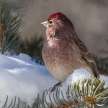
The black tinamou (Tinamus osgoodi) is a species of ground birds found in the coastal foothills and montane forests of the South American Andes. Both tinamous are from the family Tinamidae and are members of the infraclass Palaeognathae. Tinamous are their group's only members who aren't ratites, they can even float, but poorly. All paleognaths originated from ancient flying birds, and tinamous are the closest surviving relative to these birds. This tinamous species was first described by Henry Boardman Conover in 1949, based on a description provided by Cusco in Peru. Enigmatic is still an over-employed adjective but Black Tinamou certainly counts as such. A stony land creature with a short tail and long legs, the black tinamou is. It is comparatively larger than other tinamous and seems to be about 40 to 46 cm long, with females slightly larger than males. A black male tinamou has an average wingspan of around 234 to 248 mm and the average wingspan of a black female tinamou is 239 to 256 mm. While there is no estimate of the overall height of a black tinamou, a male specimen measuring 1.285 g has been examined by the Field Museum of Natural History. As the name suggests, this is mostly slate grey, rather than completely black. The upper parts of an adult black tinamou are a uniform grey while brown is sometimes edged at the mid-section and larger wing coverings. A soothy brown colour is the lower breasts and flanks, as well as the peak. This has a rufescent vent, which may or may not have black speckling depending upon the subspecies. The maxilla is dark in the mandible, with a light brown. The black tinamou has dark brown skin and the feet are blue-gray. A teenage black tinamou is similar in colour, but lined with whitish stripes on the tail. Black tinamou chicks typically have a light brown head with a long, cinnamon-brown line stretching from the crest of their heads to the napes of their necks. We have chins with whitish neckline. The collar, upper back and upper breast is a gritty black. A black tinamou chick's lower back and rump is a dark buff colour, and its lower breast and belly differ between dusky brown and light white. The black tinamou has a tremulous whistle going down which lasts about a second. The whistle sounds like a white-throated tinamou, which bears the same first note as well. There is virtually no comprehension of the actions of the black tinamou, but it is probably similar to that of his kin. The nuts were contained in one research area. The only known nest was on the ground, holding 2 shiny, blue eggs. In Peru, adults in breeding condition were recorded from March to November, and a chick was found in February. For an occurrence size of 11,600 km2, the IUCN lists the black tinamou as Vulnerable. Black Tinamou inhabits thick forests in tropical and subtropical areas and was believed to have been less than 10,000 in 2004. It has previously been known as popular locally in Peru but is now rare in that area. The black tinamou has been recorded in a number of reserves including Megantoni National Sanctuary, Manú National Park and Sira Communal Reserve in Peru, Sumaco Napo-Galeras National Park in Ecuador and Cueva de los Guácharos National Park in Colombia. The black tinamou is endangered by deforestation or habitat loss caused by human settlement production, agricultural expansion, road-building, oil exploration in Peru and food hunts. Degradation of wildlife and habitat happens within parks, too. Maybe surprisingly, despite its apparent rareness, one species nest was found in Peru; it held two eggs, which despite the congener clutch sizes may not have been a complete clutch. Fast little else is known about the life history of Black Tinamou, however.
About the Creator
MB
I am a bird aficionado and really enjoy spotting them them on hikes. I greatly appreciate the variety of birds cross North America and the world. They are amazing and intelligent creatures, each so unique and with a wonderful life.






Comments
There are no comments for this story
Be the first to respond and start the conversation.